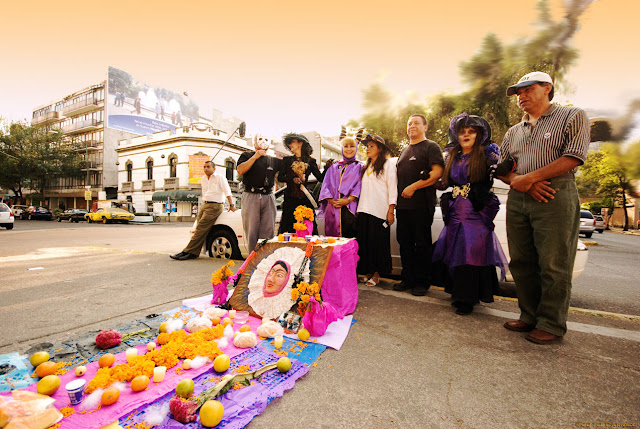The Magic of the Cities.
Zen promotes the rediscovery of the obvious, which is so often lost in its familiarity and simplicity. It sees the miraculous in the common and magic in our everyday surroundings. When we are not rushed, and our minds are unclouded by conceptualizations, a veil will sometimes drop, introducing the viewer to a world unseen since childhood. ~ John Greer
Thursday, November 3, 2011
The Day of The Dead II
Wednesday, November 2, 2011
The Day of The Dead I
 |
| La Petite Mort |
Tuesday, November 2, 2010
The Day of The Dead
 |
Monday, November 2, 2009
Day of The Dead / El Día de los Muertos

Ver.2

Scholars trace the origins of the modern holiday to indigenous observances dating back thousands of years, and to an Aztec festival dedicated to a goddess called Mictecacihuatl.
Similar holidays are celebrated in many parts of the world; for example, it's a public holiday (Dia de Finados) in Brazil, where many Brazilians celebrate by visiting cemeteries and churches. In Spain, there are festivals and parades, and at the end of the day, people gather at cemeteries and pray for their loved ones who have died. Similar observances occur elsewhere in Europe and in the Philippines, and similarly-themed celebrations appear in many Asian and African cultures.
One of the worst forms of mental suffering is boredom, not knowing what to do with oneself and one's life. Even if man had no monetary, or any other reward, he would be eager to spend his energy in some meaningful way because he could not stand the boredom which inactivity produces.
- Erich Fromm
Sunday, November 2, 2008
Dia de Muertos

Las Calacas


Tequila for The Dead

The Day of the Dead (Día de los Muertos in Spanish) is a holiday celebrated mainly in Mexico and by people of Mexican heritage (and others) living in the United States and Canada. The holiday focuses on gatherings of family and friends to pray for and remember friends and relatives who have died. The celebration occurs on the 1st and 2nd of November, in connection with the Catholic holy days of All Saints' Day and All Souls' Day which take place on those days. Traditions include building private altars honoring the deceased, using sugar skulls, marigolds, and the favorite foods and beverages of the departed, and visiting graves with these as gifts. Observance of the holiday in Mexican-American communities in the United States has become more important and widespread as the community grows numerically and economically. [Wiki.]
music+image
Gracias por su visita / Thanks for visiting.
Friday, November 2, 2007
Day of The Dead

The offerings placed on the altar for Dia de los Muertos usually consist of a wash bowl, basin, razors, soap and other items the traveling spirit can use to clean-up after the journey. Pictures of the deceased are also placed on the altar as well as personal belongings for each person and any other offerings the deceased may enjoy such as a pack of cigarettes or a bottle of tequila. Candles are used to help light the way for the spirits as well as other decorative items such as papel picado (tissue paper cut-outs) wreaths, crosses and flowers. Certain Dia de los Muertos dishes are also placed on the altar to help feed and nourish the traveling souls. Some of these offerings also double as the four main elements of nature — earth, wind, water, and fire. These are represented by movable or light-weight items such as tissue paper cut-outs (wind,) a bowl of water, candles (fire) and food (crops, earth.) Chelsie Kenyon.
Gracias por su visita / Thanks for visiting.
Wednesday, October 31, 2007
Ofrenda / Offering

'Offering in the window of a library'
The offerings placed on the altar for Dia de los Muertos usually consist of a wash bowl, basin, razors, soap and other items the traveling spirit can use to clean-up after the journey. Pictures of the deceased are also placed on the altar as well as personal belongings for each person and any other offerings the deceased may enjoy such as a pack of cigarettes or a bottle of tequila. Candles are used to help light the way for the spirits as well as other decorative items such as papel picado (tissue paper cut-outs) wreaths, crosses and flowers. Certain Dia de los Muertos dishes are also placed on the altar to help feed and nourish the traveling souls. Some of these offerings also double as the four main elements of nature — earth, wind, water, and fire. These are represented by movable or light-weight items such as tissue paper cut-outs (wind,) a bowl of water, candles (fire) and food (crops, earth.) Chelsie Kenyon.
Gracias por su visita / Thanks for visiting.
Thursday, October 19, 2006
Dia de Muertos / Day of The Dead


Shop window of a candy store.
The Day of The Dead
Her face is unforgettable and she goes by many names: La Catrina, la Flaca, la Huesuda, la Pelona--Fancy Lady, Skinny, Bony, Baldy. A fixture in Mexican society, she's not some trendy fashion model, but La Muerte--Death.
Renowned writer Octavio Paz observes that, undaunted by death, the Mexican has no qualms about getting up close and personal with death, noting that he "...chases after it, mocks it, courts it, hugs it, sleeps with it; it is his favorite plaything and his most lasting love."
November 1, All Saints Day, and November 2, All Souls Day are marked throughout
In most localities November 1 is set aside for remembrance of deceased infants and children, often referred to as angelitos (little angels). Those who have died as adults are honored November 2.
From mid-October through the first week of November, markets and shops all over
Copyright 1995 by Dale Palfrey. All rights reserved.
http://www.mexconnect.com/mex_/feature/daydeadindex.html














